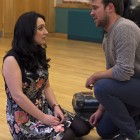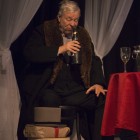Bohème 2016Edinburgh Grand Opera
Read more about the opera Bohème
La bohème is an opera that, despite its continuing popularity, presents great difficulties to companies who decide to put it on. The four acts are highly contrasted, but demand a degree of realism. The six central roles need to be played by singers who can create individual characters, sing beautifully and command the stage in antics that many find difficult to do without embarrassment. The conductor needs to keep all this under control while coaxing beautiful sounds from the pit. Finally, the director and designer have to come up with a concept that makes all these elements gel. It is surprising it ever gets done successfully at all.
Kally Lloyd-Jones and Janis Hart started from the sensible idea that a setting in Paris a couple of decades before the First World War - the bel époque - might work. There was plenty going on in the field of modern art and culture, plenty of poverty, no antibiotics - and 1896 was the year of the work's first performance. The costumes were simpler (and cheaper) than the original period fifty years earlier would have required. The setting was a basic white box, with a couple of large picture frames dangling from the flies - did Marcello ever get round to finishing a painting? The lighting by Laura Hawkins also worked well - white for the wintry start, slightly lurid for the café and darkly moody for the final tragedy.
The casting worked well. The two less central students, Colline and Schaunard, were played as older men, and both sang well. Donald Thomson's real bass sounded smooth and easy in the farewell to his coat. The central quartet were well balanced - Deborah Rudden made an appealing Mimì, with a rich soprano just right for the part. Hazel McBain's Musetta provided just the necessary contrast - lively without being too sluttish - that maintains audience sympathy.
Douglas Nairne has had plenty of experience singing Marcello with Opera Bohemia, and it showed with his easy movement about the stage and sympathetic characterization. Here, the use of idiomatic Italian and the presence of a small orchestra gave him the chance to go further. Luke Sinclair's tenor continues to develop impressively, and he had no difficulties with the role vocally at all. What he needs to do is introduce a bit more colour and subtlety into his singing - mainly by turning down the volume. In the third act quartet he started to caress the music, and the improvement was immediate. He is always a sympathetic actor.
When a member of the cast drops out, it is a lucky company that can draw at short notice on the services of one of its patrons. In this case Donald Maxwell came in to give two cameo roles he did a number of times in the classic, recently retired, John Copley and Julia Trevelyan Oman staging at Covent Garden. Benoit and Alcindoro only appear for a few minutes, but the young performers must have learned a huge amount from working with this consummate artist.
For the most part, Susannah Wapshott did well as conductor, pacing things naturally. The reduction of the score (by Tony Burke - quintets of strings and woodwind, plus percussion) makes it unavoidable that there will be times when it sounds a bit thin, but that is acceptable in these circumstances. If there was one minor quibble with the staging it was perhaps one of climate. Given that there was generally an attempt to portray things realistically, the first and third acts did not seem quite cold enough - the peasant women quite under-dressed for a winter dawn - while the last had little sense of heat, which would also have shown the passage of time.
Was it a good idea to perform in Italian? Clearly it is useful training for young professionals, and it is to be hoped they will get the chance to sing the parts on some of our main stages in future. However the chorus members were certainly far less idiomatic, and the question remains unresolved. Perhaps a work with more for the chorus to do will present a different challenge.










